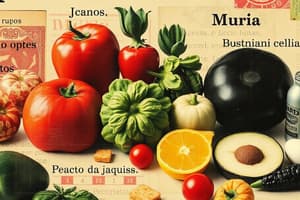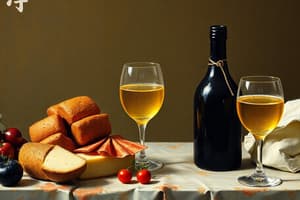Podcast
Questions and Answers
Which of the following is a type of fruit?
Which of the following is a type of fruit?
- Carrot
- Chicken
- Bread
- Apple (correct)
The phrase 'spicy and delicious' is a way to describe food.
The phrase 'spicy and delicious' is a way to describe food.
True (A)
What is a common way to describe the texture of food?
What is a common way to describe the texture of food?
crispy, chewy, soft
A ______ fruit is known for its high vitamin C content.
A ______ fruit is known for its high vitamin C content.
Match the following food items with their descriptions:
Match the following food items with their descriptions:
Which food group is primarily known for being a concentrated source of energy?
Which food group is primarily known for being a concentrated source of energy?
What is a primary function of proteins in the diet?
What is a primary function of proteins in the diet?
Which food group is typically low in calories and high in nutrients?
Which food group is typically low in calories and high in nutrients?
Which type of food is primarily composed of edible seeds of cereal crops?
Which type of food is primarily composed of edible seeds of cereal crops?
What is a significant characteristic of sweets and treats?
What is a significant characteristic of sweets and treats?
Flashcards are hidden until you start studying
Study Notes
Types of Food
- Fruits: Edible plant parts that can be sweet or sour, rich in vitamins, minerals, and fiber. Common examples include apples, bananas, oranges, and berries.
- Vegetables: Edible sections of plants like leaves, roots, and stems, packed with nutrients yet low in calories. Examples include spinach, carrots, broccoli, and peppers.
- Grains: Seeds from cereal crops that provide carbohydrates, fiber, and essential nutrients. Notable examples are rice, wheat, oats, and barley.
- Proteins: Crucial macronutrients for body repair and growth, obtained from both animal and plant sources. Common sources are meat, fish, eggs, legumes, nuts, and tofu.
- Dairy: Food products originated from milk, rich in calcium, protein, and vitamins. Examples include milk, cheese, yogurt, and butter.
- Fats and Oils: High-energy sources necessary for hormone regulation and nutrient absorption. Examples include olive oil, butter, nuts, and avocados.
- Sweets and Treats: Foods high in sugar but low in essential nutrients, typically enjoyed in moderation, such as candies, cakes, ice cream, and pastries.
- Beverages: Liquid foods that can hydrate or energize, including water, juice, tea, coffee, and alcoholic drinks.
Food Groups and Nutritional Value
- Macronutrients:
- Carbohydrates serve as the primary energy source.
- Proteins act as the body's building blocks.
- Fats are vital for energy storage and cell function.
- Micronutrients:
- Vitamins are organic compounds crucial for various bodily functions.
- Minerals are inorganic elements needed for essential processes like bone formation.
Dietary Considerations
- Balanced Diet: Essential for ensuring a complete range of nutrients by including a variety of food types.
- Food Preferences: Influenced by factors like culture, health status, food availability, and personal taste.
- Dietary Restrictions: Arise from allergies, intolerances, or ethical choices, such as vegetarianism or veganism.
Food Preparation and Preservation
- Techniques such as cooking, baking, fermenting, and freezing aim to enhance food flavors and textures, improve nutritional value, and extend shelf life.
Global Cuisines
- Diverse food practices stem from cultural traditions and ingredient availability, shaped by geographical features, climate, and historical trade interactions.
Studying That Suits You
Use AI to generate personalized quizzes and flashcards to suit your learning preferences.




